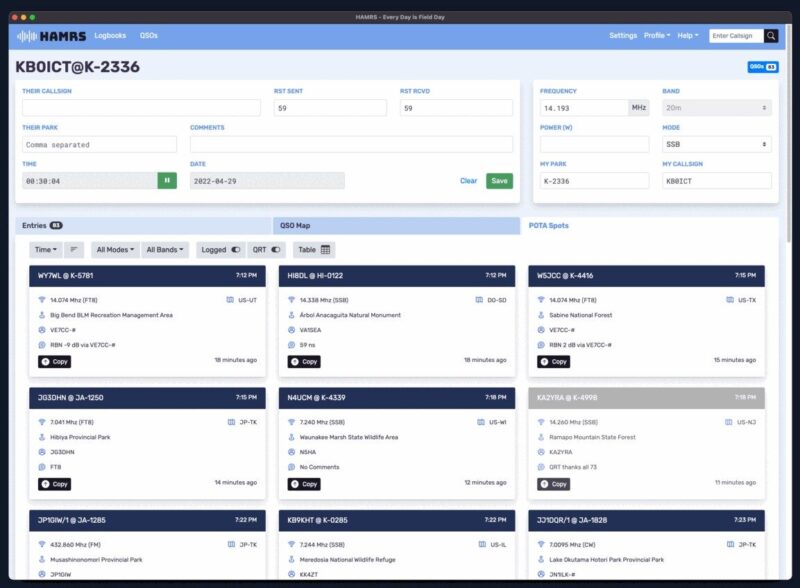A simple, portable logger tailored for activities like Parks on the Air, Field Day, and more.
HAMRS is a fast, easy-to-use logging program speciically built for portable operations such as POTA, SOTA, or ARRL Field Day. HAMRS is similar to other logging programs but is optimized to run on small screens and multiple platforms, and it provides speciic log ields and functions for portable operating activities. It was created by Jarrett Green, KBØICT, who has deliberately kept it straightforward and easy to use. HAMRS runs on macOS, iOS, Windows, Ubuntu Linux, and Raspbian. It runs ine on my iPhone, iPad, HP Windows 10 shack computer, and Dell Windows 11 laptop. I had my friend Martin Ewing, AA6E, install the program on his Android phone, and it also ran ine on that operating system.
While the macOS, Windows PC, Ubuntu, and Raspbian versions are free for download from the manufacturer’s website (www.hamrs.app), the HAMRS mobile version needs to be purchased and downloaded from the Apple App Store (for an iOS device, it’s the same app for iPhone and iPad) or from the Google Play Store for Android users. The price is reasonable — a cup of coffee at my local coffee shop costs more!
 Operation
Operation
HAMRS has an intelligently laid-out, well-organized user interface. On the iPad version, the left side of the screen is organized by contact information including the call sign signal report, date, time, and location. The right side is organized by your station’s operating information including band, mode, park, grid, etc. This information is displayed vertically rather than horizontally on the iPhone version (see Figure 18). Another nice touch is that when characters are entered in a ield, they are all upper case. There is no need to switch between upper- and lower-case letters. Before you begin logging contacts, you need to set the date and UTC time.
These are set automatically on iOS devices. You then enter your station’s band, mode, power, park number, grid, and country. These ields remain the same from QSO to QSO unless you change them. Once everything is set up, to log a contact, you enter the contact’s call sign and hit SAVE, and the data goes into the log automatically. This makes contact entry very fast. On the iPad or iPhone, completed QSOs are displayed on the irst tab in a table below the operating ields. The Windows version can also display QSOs in either table format or boxes similar to the POTA web app. In table format, ields can be sorted in ascending or descending order. A speciic call sign can also be queried from the database. Two additional tabs are adjacent to the log table in the POTA template. The second tab displays a QSO map of all the QSOs in the log either with or without their call signs, and the map can be zoomed in and out. However, there is no way to download the map. When HAMRS is connected to the web, the third tab displays POTA spots in real time.
These can be iltered similarly to the ilters on the POTA web app. An individual spot on the display can be entered into the log by pushing the COPY button on the displayed spot. When a log is closed, you can edit, duplicate, export, or delete a log. I use the EXPORT.ADI function to upload the iPad .adi ile into my Dropbox account while I am at the park. When I return to my home station, I use a Windows ADIF utility program (ADIF Master) to create an upload ile for the POTA app. I use the same .adi ile to import the log to my home station’s logging program. HAMRS lacks some of the features of more advanced logging programs, but many of these are purposely excluded to keep the program easy to use, light, and fast. There is no facility to import QSOs from another log. Queries beyond call signs are limited, and there is no direct upload provision to other platforms. There is no rig control yet, but that may be available in the future according to the HAMRS support group.

Support
HAMRS is supported by question-and-answer support on the app, the HAMRS website, and Discord. There is limited individual user support by the developer. I created a login and signed up to receive email information from the HAMRS support group. Like other webbased support groups, this service posts lots of useful information about the program. Besides paying the mobile device app fee, you can also support HAMRS by donating to “Help KB0ICT keep working on HAMRS!” on the HAMRS website. Three optional monthly membership support choices provide additional beneits such as “early access to Beta and Preview Builds on all devices.” Conclusion I use HAMRS for portable operations, and I have been pleased with its operation. It’s hard to beat for its modest price. Like most software-based logging software, HAMRS revises its software with new features and improvements. So, be sure to check their website for the latest updates. Also, there is now a completely new web version available at https://logger.hamrs.app — this is serving as a test for the rewrite that will soon make its way to desktop and mobile. Manufacturer: Cabin Interactive, LLC, www.hamrs. app.
Price: iOS version (Apple App Store), $4.99;
Android version (Google Play Store), $4.99; the macOS, Windows PC, Ubuntu (Linux), and Raspbian versions are free to download.

